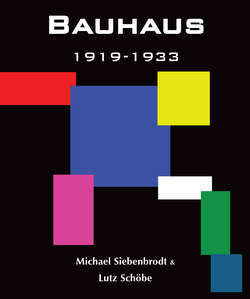Bauhaus. 1919-1933

Реклама. ООО «ЛитРес», ИНН: 7719571260.
Оглавление
Michael Siebenbrodt. Bauhaus. 1919-1933
Preface
History of the Bauhaus
Forerunners, Roots and History
Art School Reform
Ruskin, Olbrich and Others
Deutscher Werkbund (German Association of Craftsmen)
De Stijl, Blauer Reiter (Blue Rider) and Der Sturm
The Staatliches Bauhaus in Weimar (1919 to 1925)
Between Vision and Reality: The 1919 to 192 °Construction Phase
On the Way to [Becoming] the Modern Academy of Design: The 1921–1922 Formation Phase
“Art and Technology – A New Unity” and the 1923 Bauhaus Exhibition
Bauhaus Dessau: Academy for Design (1925 to 1932)
The Bauhaus Becomes an Academy
Laboratories for Industry – Workshop Work
Planning and Building
The Hannes Meyer Era
The Ludwig Mies van der Rohe Era
The Closure of the Bauhaus in Dessau
Bauhaus Berlin: Free Education and Research Institute (1932–1933)
The Closure of the Bauhaus in Berlin
Preparatory Course and Basic Design Education
The Preparatory Course
Wassily Kandinsky’s Course
Paul Klee’s Course
Oskar Schlemmer’s Course
Joost Schmidt’s Course
The Workshops. Pottery Workshop
Bookbinding
Stained Glass Painting Workshop
Graphic Print Shop
Typography/Printing and Advertising Workshop
Mural Painting Workshop
Stone Sculpting and Woodcarving/Plastic Workshop
Weaving Workshop
Carpentry/Furniture Workshop
Metal Workshop
Theatre Workshop
Architecture/Building Studies / Building Department
Photography/Photo Workshop
The Photography Workshop
Fine Arts
Life and Work
Effect and Reaction
Bauhaus and the Third Reich
The Bauhaus and the United States
The Bauhaus and the Soviet Union
The Bauhaus and the Federal Republic of Germany
Bauhaus and the GDR (German Democratic Republic)
Bauhaus in Reunified Germany
Bauhaus: A Creative Method
Chronology
Bibliography
Bauhaus Teachers
Bauhaus – Archives, Collections and Museums
Отрывок из книги
The Bauhaus was one of the most important and momentous cultural manifestations of the twentieth century. There is no doubt about it. It is more than ever a phenomenon of global dimensions. Today, the Bauhaus is embedded in the public consciousness; it is held in high esteem and, depending on one’s interests, occasionally glorified or denounced. But recognition and positive esteem are prevalent. The work of the Bauhaus artists enjoys universal admiration and interest in the great museums of the world. Their creative theories, if often taken out of their complex context, received and continue to receive attention in many renowned architectural and art education institutes, as well as in basic art lessons in education facilities. Bauhaus products – such as Marcel Breuer’s famous tubular steel furniture – proceeded to become highly-traded design classics. Bauhaus buildings, such as the sites in Weimar and Dessau, are considered pieces of architectural history, and today they are part of Germany’s cultural heritage. The Bauhaus went down in art history as the original modernist art school.
Now, almost a century after its foundation, it is still current. This is evident not only in the increased institutional interest in the school’s work, an exhibition boom that hasn’t worn off, and a multitude of new publications and unending media interest, but also in the area of theoretical architectural research, in which investigations into functionalism, a design concept closely connected to the Bauhaus, are on the increase. The creation of a new man for a new, more humane society was the Bauhaus’s true goal. It remains historically unfulfilled. Are we to understand the intervention by philosopher and sociologist Jürgen Habermas regarding “modernism as an unfinished project” in this way, too?
.....
On the 3rd November 1918, revolution began in Germany and reached Weimar five days later. On the 9th, the social Democrat Philipp Scheidemann (1865–1939) proclaimed the “German Republic” in the Reichstag, and two hours later Karl Liebknecht proclaimed his “Free Socialist Republic” at Berlin Castle. The Kaiser and all the German princes abdicated without any far-reaching radical social changes.
On 3rd December 1918, the first meeting of the November Group took place in Berlin. It was an association of artists and architects such as Lyonel Feininger (1871–1956), Wassily Kandinsky, Walter Gropius and Ludwig Mies van der Rohe, and also included Max Pechstein (1881–1955), Otto Dix (1891–1969), George Grosz (1893–1959) and Hans Poelzig (1869–1936), who wanted to make their contribution to the building of the young republic. Parallel to this gathering, the Working Council of the Arts was formed, including a group intent on reforming the education system led by architect Otto Bartning (1883–1959), with whom Gropius also collaborated. A central question was the creation of equal opportunities for all students by means of a unified school, in connection with the idea of a working school. Special emphasis was placed on the reform of fine arts academies. The results of these discussions were also expressed in an only slightly modified form in Walter Gropius’s Bauhaus Programme and Manifesto, which appeared in April 1919 with Lyonel Feininger’s woodcut on the cover. The reunification of all artistic principles in building, in combination with manual trades and workshop as educational fundamentals were the focal point of its aims and objectives. The Masters, Journeymen and Apprentices of the Bauhaus were to be closely in touch with industry and public life and strive for friendly relationships amongst themselves outside of classes as well as in them, with theatre, lectures, music and “ceremonious merriment at these gatherings.”[2]
.....